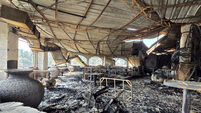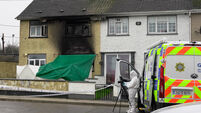Qantas orders fleet-wide probe after jet blast
Australian airline Qantas moved to inspect oxygen cylinders on its entire fleet today as investigators focused on a missing tank as the suspected cause of a mid-air blast that tore a hole in a jumbo jet carrying more than 350 people.
The chief executive of Qantas Airways said today that whatever caused the mid-air emergency was more than likely beyond the control of the airline.
Geoff Dixon’s comment to a news conference suggested the cause of the Friday’s incident was a mechanical fault.
Mr Dixon also said that a US aviation agency directive in April warning about oxygen tank concerns on airliners “was not anything to do” with the potential cause of Friday’s incident.
Australia’s Civil Aviation Safety Authority said Qantas was ordered to quickly inspect every oxygen bottle aboard its fleet of 30 Boeing 747s.
Civil authority spokesman Peter Gibson confirmed an oxygen cylinder was missing from the Boeing 747-400 from London that made an emergency landing in Manila, in the Philippines, on Friday after a section of its metal skin was ripped away at 29,000 feet over the South China Sea. There were no injuries.
“If it turns out that is the cause of the accident, the cause of the hole in the side of the aircraft, obviously that will be a key part of the investigation working out why a bottle would suddenly give way,” Mr Gibson told Australian Broadcasting Corporation radio.
“As far as we can determine this has never happened before on a passenger aircraft,” he said, adding the possibility was “very unusual and obviously understanding why that happened will be absolutely critical to making sure it can’t occur again”.
He said a possible cause of the blast could include metal fatigue in the cylinder, a failure of the regulator valve, something hitting it and puncturing it, or the cylinder becoming too hot.
A senior investigator from the Australian Transport and Safety Bureau, Neville Blyth, said yesterday the incident was treated as a safety investigation.
“At this stage, there is no evidence whatsoever that this is a security-related event,” he said. An official of the US Transportation Security Administration also said initial reports indicated no link to terrorism.
Mr Gibson said an inspection of all oxygen canisters in Qantas’ fleet would take several days. He said tanks located near the hole contained emergency oxygen for the flight deck.
Boeing spokeswoman Liz Verdier said the design of the Qantas jet included dozens of oxygen tanks located throughout the lower part of the aircraft, including below the passenger compartment where the hole formed.
Ms Verdier said it was too soon to say what caused the explosion or whether the canisters may have contributed to the blast.
Passengers described the plane being shaken by a loud bang. Oxygen masks dropped from the ceiling due to rapid decompression caused by the 9ft hole in its fuselage, and the plane descended rapidly as debris flew through the cabin.
The plane, en route from London to Melbourne, Australia, had made a stopover in Hong Kong an hour earlier.
Four Australian Transport Safety Bureau specialists began inspecting the aircraft on Saturday and were expected to continue their work for two or three days with assistance from Boeing and the US National Transportation Safety Board.
Qantas boasts a strong safety record and has never lost a jet to an accident. Its last crash of a smaller plane was in 1951.













